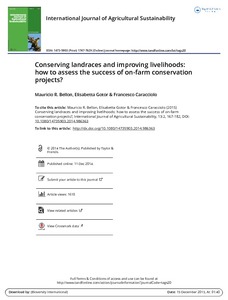Resource information
Smallholder farmers who grow diverse landraces in centres of crop diversity contribute to sustaining the capacity of agricultural and food systems to adapt to change by maintaining crop evolution in their fields today, thus enabling humanity to continue to have the broad genetic variation needed to adapt crops to changes tomorrow. Given this fact, the last 20 years have witnessed an ever-growing interest in on-farm conservation of crop infra-specific diversity. While numerous projects to support it have been, and continue to be, implemented worldwide, there has been very little systematic assessment of the extent to which these projects have been effective at contributing to the maintenance of crop diversity on-farm and the creation of associated benefits for the farmers involved. The factors and relationships implicated in attaining conservation and livelihood results are complex, so that a conceptual scheme that brings them together in a simplified but coherent fashion can be extremely useful for the scientists, donors, policy-makers and practitioners concerned. This paper presents a conceptual framework for analysing on-farm projects, the trade-offs involved and assesses their success in a more systematic way.



